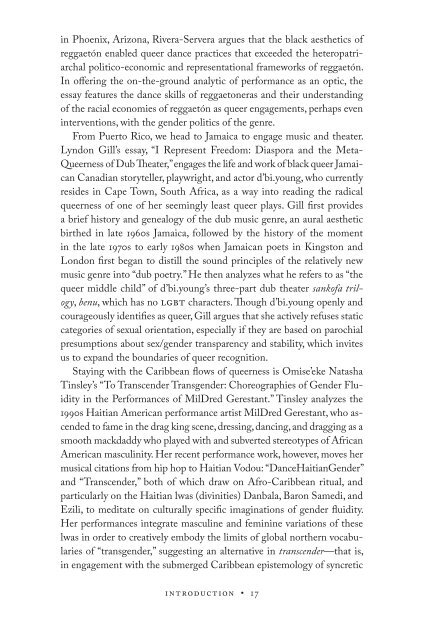No Tea
89AS6wvrf
89AS6wvrf
You also want an ePaper? Increase the reach of your titles
YUMPU automatically turns print PDFs into web optimized ePapers that Google loves.
in Phoenix, Arizona, Rivera- Servera argues that the black aesthetics of<br />
reggaetón enabled queer dance practices that exceeded the heteropatriarchal<br />
politico- economic and repre sen ta tional frameworks of reggaetón.<br />
In offering the on- the- ground analytic of per for mance as an optic, the<br />
essay features the dance skills of reggaetoneras and their understanding<br />
of the racial economies of reggaetón as queer engagements, perhaps even<br />
interventions, with the gender politics of the genre.<br />
From Puerto Rico, we head to Jamaica to engage music and theater.<br />
Lyndon Gill’s essay, “I Represent Freedom: Diaspora and the Meta-<br />
Queerness of Dub Theater,” engages the life and work of black queer Jamaican<br />
Canadian storyteller, playwright, and actor d’bi.young, who currently<br />
resides in Cape Town, South Africa, as a way into reading the radical<br />
queerness of one of her seemingly least queer plays. Gill first provides<br />
a brief history and genealogy of the dub music genre, an aural aesthetic<br />
birthed in late 1960s Jamaica, followed by the history of the moment<br />
in the late 1970s to early 1980s when Jamaican poets in Kingston and<br />
London first began to distill the sound princi ples of the relatively new<br />
music genre into “dub poetry.” He then analyzes what he refers to as “the<br />
queer middle child” of d’bi.young’s three- part dub theater sankofa trilogy,<br />
benu, which has no lgbt characters. Though d’bi.young openly and<br />
courageously identifies as queer, Gill argues that she actively refuses static<br />
categories of sexual orientation, especially if they are based on parochial<br />
presumptions about sex/gender transparency and stability, which invites<br />
us to expand the bound aries of queer recognition.<br />
Staying with the Ca rib bean flows of queerness is Omise’eke Natasha<br />
Tinsley’s “To Transcender Transgender: Choreographies of Gender Fluidity<br />
in the Per for mances of MilDred Gerestant.” Tinsley analyzes the<br />
1990s Haitian American per for mance artist MilDred Gerestant, who ascended<br />
to fame in the drag king scene, dressing, dancing, and dragging as a<br />
smooth mackdaddy who played with and subverted ste reo types of African<br />
American masculinity. Her recent per for mance work, however, moves her<br />
musical citations from hip hop to Haitian Vodou: “DanceHaitianGender”<br />
and “Transcender,” both of which draw on Afro- Caribbean ritual, and<br />
particularly on the Haitian lwas (divinities) Danbala, Baron Samedi, and<br />
Ezili, to meditate on culturally specific imaginations of gender fluidity.<br />
Her per for mances integrate masculine and feminine variations of these<br />
lwas in order to creatively embody the limits of global northern vocabularies<br />
of “transgender,” suggesting an alternative in transcender— that is,<br />
in engagement with the submerged Ca rib bean epistemology of syncretic<br />
Introduction • 17


